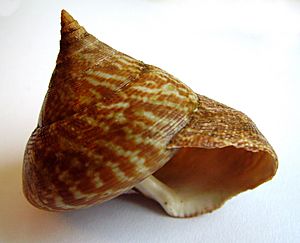Calliostoma tigris facts for kids
Quick facts for kids Calliostoma tigris |
|
|---|---|
 |
|
| A shell of Calliostoma tigris | |
| Scientific classification | |
| Kingdom: | |
| Phylum: | |
| Class: | |
| (unranked): |
clade Vetigastropoda
|
| Superfamily: |
Trochoidea
|
| Family: |
Calliostomatidae
|
| Subfamily: |
Calliostomatinae
|
| Tribe: |
Calliostomatini
|
| Genus: | |
| Species: |
C. tigris
|
| Binomial name | |
| Calliostoma tigris tigris (Gmelin, 1791)
|
|
| Synonyms | |
|
|
Calliostoma tigris, often called the tiger maurea, is a very large type of sea snail. It is a mollusc that lives in the ocean. This snail belongs to a group called gastropods, which includes all snails and slugs. It is part of the Calliostomatidae family, sometimes known as "top snails" because of their shell shape. Some experts also place this snail in a special group called Calliostoma (Maurea).
Contents
What Does the Tiger Maurea Look Like?
The shell of the tiger maurea can be quite big. It usually measures between 50 mm (about 2 inches) and 96 mm (about 3.8 inches) tall. This makes it one of the largest Calliostoma species.
Shell Shape and Color
The shell is shaped like a cone. It is strong but not too thick. The color is usually light yellowish. It has many thin, reddish-brown stripes running down its length. These stripes are often uneven.
Shell Surface Details
The very first parts of the shell, called the embryonic whorls, are smooth. The other parts of the shell have many delicate, beaded lines. These lines are called lirulae. On the second-to-last whorl, there are about 16 to 20 of these lines. The largest part of the shell, called the body whorl, has about 18 to 25 lirulae.
Spire and Whorls
The top part of the shell, called the spire, is tall. Its sides curve inward slightly. The lines where the whorls join, called sutures, are a little bit indented. The shell has 10 to 12 whorls in total. The whorls on the spire are flat. The last whorl is rounded at its edge. The tiny bumps on the shell are very fine and even. They do not disappear on the outer part of the base.
Inside the Shell
The opening of the shell, called the aperture, is shaped like a diamond. The inside of the shell is shiny and iridescent, like a rainbow. The central pillar inside the shell, called the columella, is also pearly. It has a blunt bump at its base.
Where They Live and What They Eat
You can usually find these snails clinging to rock walls. They also like to hide underneath overhangs in underwater caves. They live in depths from 10 meters (about 33 feet) to 200 meters (about 656 feet) deep. They prefer coastlines that are semi-exposed to very exposed. The tiger maurea eats small animals like hydroids and other creatures that grow on rocks.
Where Does the Tiger Maurea Live?
This sea snail lives only in New Zealand. In New Zealand, it is also known by its Māori names: rehoreho or matangongore. Interestingly, the name matangongore is also used for another type of topshell called Cantharidus opalus.
See also
 In Spanish: Calliostoma tigris para niños
In Spanish: Calliostoma tigris para niños

